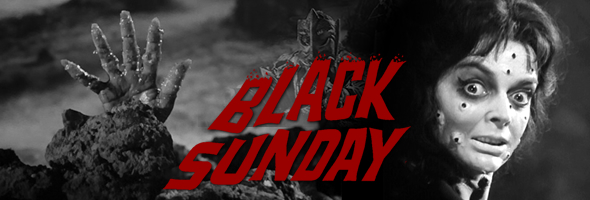

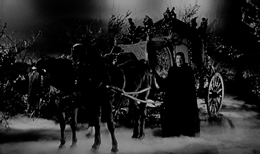 Asa (Steele) and her henchman Javutich (Dominici) are condemned by her brother to be burned at the stake, the powerful witch decrees a curse upon the family of Vajda and gets a spiked demon mask hammered into her face as extra punishment. Two centuries later, young doctor Andre Gorobec (Torso's Richardson) and his mentor, Dr. Kruvajan (Checci), are waylaid during a coach ride to a medical conference. Beautiful Katia (Steele again), the youngest in the Vajda bloodline, meets them in a graveyard, the resting place of Asa, while walking a pair of mastiffs and bids them to join her at home where her father (Garrani) is ailing. However, a bat attack before their
Asa (Steele) and her henchman Javutich (Dominici) are condemned by her brother to be burned at the stake, the powerful witch decrees a curse upon the family of Vajda and gets a spiked demon mask hammered into her face as extra punishment. Two centuries later, young doctor Andre Gorobec (Torso's Richardson) and his mentor, Dr. Kruvajan (Checci), are waylaid during a coach ride to a medical conference. Beautiful Katia (Steele again), the youngest in the Vajda bloodline, meets them in a graveyard, the resting place of Asa, while walking a pair of mastiffs and bids them to join her at home where her father (Garrani) is ailing. However, a bat attack before their 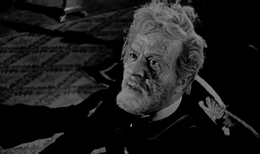 departure causes a knocked-over cross and some crucial droplets of blood to slowly revive Asa, who summons Javutich from his tomb as well to help her unleash her supernatural fury on the descendants of those who executed her.
departure causes a knocked-over cross and some crucial droplets of blood to slowly revive Asa, who summons Javutich from his tomb as well to help her unleash her supernatural fury on the descendants of those who executed her.
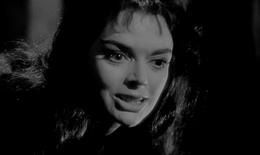 As accomplished as Bava's visual mastery may have been, this film wouldn't have had quite the same impact without the pivotal central performance by Barbara Steele, an English-born actress who had essentially given up on Hollywood after leaving the Elvis Presley production Flaming Star. By the time the Americanized Black Sunday opened in early 1961, she was back in America making an (uncredited) appearance as a fashion model at the 33rd Academy Awards and making Pit and the Pendulum for Roger Corman, contributing to one of the screen's most blood-freezing final shots. Though she returned to Italy again to work for Fellini on 8 1/2, it's her horror legacy that's ensured her an immortal fan following thanks to Black Sunday and its progeny like Castle of Blood, The Horrible Dr. Hichcock, Nightmare Castle, The Ghost, and Long Hair of Death. Her mesmerizing, unorthodox beauty still makes her the ideal European horror icon, a jagged yet voluptuous embodiment of the fears and desires of the audience.
As accomplished as Bava's visual mastery may have been, this film wouldn't have had quite the same impact without the pivotal central performance by Barbara Steele, an English-born actress who had essentially given up on Hollywood after leaving the Elvis Presley production Flaming Star. By the time the Americanized Black Sunday opened in early 1961, she was back in America making an (uncredited) appearance as a fashion model at the 33rd Academy Awards and making Pit and the Pendulum for Roger Corman, contributing to one of the screen's most blood-freezing final shots. Though she returned to Italy again to work for Fellini on 8 1/2, it's her horror legacy that's ensured her an immortal fan following thanks to Black Sunday and its progeny like Castle of Blood, The Horrible Dr. Hichcock, Nightmare Castle, The Ghost, and Long Hair of Death. Her mesmerizing, unorthodox beauty still makes her the ideal European horror icon, a jagged yet voluptuous embodiment of the fears and desires of the audience.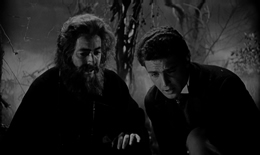 ers since the Image release in 1999. The film itself was mostly shot in English on the set, though Steele's real voice was never used for any version. This full-strength edition actually turned up on VHS a few years earlier from Sinister Cinema and caused a bit of a stir in the horror community, but the official Image release really got the ball rolling by offering the film in pristine condition (for the time) along with illuminating extras... but more on that in a minute. Meanwhile the American version, which replaced the sparing Roberto Nicolosi score with a more traditionally aggressive and spooky one by the great Les Baxter, fell into the hands of Orion Pictures, seeing its first authorized home video release paired with Bava's Black Sabbath as a two-platter laserdisc release from Image well before the days of DVD. The AIP cut now resides with MGM, who has stymied efforts to include it (as well as their valuable variants of other Bava films) on any other American releases to date, a fate identical to that of Black Sabbath. The AIP version was announced as an option for the second DVD version from Anchor Bay, but for those obvious reasons, it never came to pass.
ers since the Image release in 1999. The film itself was mostly shot in English on the set, though Steele's real voice was never used for any version. This full-strength edition actually turned up on VHS a few years earlier from Sinister Cinema and caused a bit of a stir in the horror community, but the official Image release really got the ball rolling by offering the film in pristine condition (for the time) along with illuminating extras... but more on that in a minute. Meanwhile the American version, which replaced the sparing Roberto Nicolosi score with a more traditionally aggressive and spooky one by the great Les Baxter, fell into the hands of Orion Pictures, seeing its first authorized home video release paired with Bava's Black Sabbath as a two-platter laserdisc release from Image well before the days of DVD. The AIP cut now resides with MGM, who has stymied efforts to include it (as well as their valuable variants of other Bava films) on any other American releases to date, a fate identical to that of Black Sabbath. The AIP version was announced as an option for the second DVD version from Anchor Bay, but for those obvious reasons, it never came to pass.
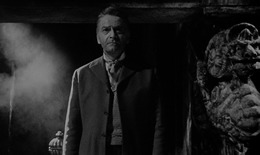 Of course, in terms of home video history the biggest feature here is first Bava audio commentary by Video Watchdog's Tim Lucas, which has become a mainstay of the film's subsequent English releases and kicked off a series of future Bava commentaries for the future author of the spectacular Mario Bava: All the Colors of the Dark. It's a terrific dry run for the epic study of the film included in his book, laying out some tantalizing theories about directions the film might have taken including speculation different narrative points for Katia's possession. The facts keep coming fast and furious right up until the end, offering a dizzying master class in Italian horror history in less than 90 minutes. The commentary appeared again when Anchor Bay snagged the film in 2007 and released it both as a standalone title and part of their first, five-film Mario Bava box set, which featured a port of the same video master with a little additional damage removal and all of the extras apart from the wild American radio spots featuring Paul Frees, which were included on the Image DVD menu screen.
Of course, in terms of home video history the biggest feature here is first Bava audio commentary by Video Watchdog's Tim Lucas, which has become a mainstay of the film's subsequent English releases and kicked off a series of future Bava commentaries for the future author of the spectacular Mario Bava: All the Colors of the Dark. It's a terrific dry run for the epic study of the film included in his book, laying out some tantalizing theories about directions the film might have taken including speculation different narrative points for Katia's possession. The facts keep coming fast and furious right up until the end, offering a dizzying master class in Italian horror history in less than 90 minutes. The commentary appeared again when Anchor Bay snagged the film in 2007 and released it both as a standalone title and part of their first, five-film Mario Bava box set, which featured a port of the same video master with a little additional damage removal and all of the extras apart from the wild American radio spots featuring Paul Frees, which were included on the Image DVD menu screen.
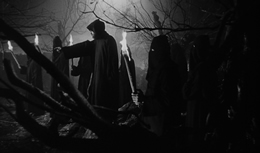 atchet for the Honeymoon, Lisa and the Devil, and House of Exorcism). This is an even crisper transfer of the English-language European version with all the violence intact, and the European English dialogue and music track (with Nicolosi's score) as the sole audio option. (Too bad the Italian audio has never been made available in English-speaking territories as it's the most elegant of all the options out there, even if it's the least faithful to the actors' lip movements.) This looks extremely close to the 35mm print of the film exhibited by rights holder Alfredo Leone since the late '90s, and it's difficult to imagine the film looking any better without a very expensive restoration overhaul. The opening scene still looks (intentionally) dark and murky, but after the credits (bearing the Mask of Satan title with a caption identifying the one on the actual packaging) things generally sharpen up for a bold and pleasing presentation that demonstrates how far transfer technology has come. There's also some damage in the opening shot, but after that it's mostly smooth sailing as far as clarity goes. The formerly tricky layers of darkness in the night scenes are easier to appreciate here, and crucial shots like Javutich's crawl from his grave and the great nocturnal shot of his coach passing through the woods now have the visual power they once only possessed on the big screen.
atchet for the Honeymoon, Lisa and the Devil, and House of Exorcism). This is an even crisper transfer of the English-language European version with all the violence intact, and the European English dialogue and music track (with Nicolosi's score) as the sole audio option. (Too bad the Italian audio has never been made available in English-speaking territories as it's the most elegant of all the options out there, even if it's the least faithful to the actors' lip movements.) This looks extremely close to the 35mm print of the film exhibited by rights holder Alfredo Leone since the late '90s, and it's difficult to imagine the film looking any better without a very expensive restoration overhaul. The opening scene still looks (intentionally) dark and murky, but after the credits (bearing the Mask of Satan title with a caption identifying the one on the actual packaging) things generally sharpen up for a bold and pleasing presentation that demonstrates how far transfer technology has come. There's also some damage in the opening shot, but after that it's mostly smooth sailing as far as clarity goes. The formerly tricky layers of darkness in the night scenes are easier to appreciate here, and crucial shots like Javutich's crawl from his grave and the great nocturnal shot of his coach passing through the woods now have the visual power they once only possessed on the big screen.
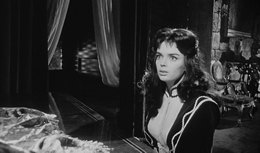 However, that turned out to be far from the definitive Black Sunday; as of now, that honor easily goes to the 2013 Blu-Ray from Arrow in the UK (packaged as a dual-format release with a DVD), which plays like a Bava fan's ultimate wish list come true. You get the European Mask of Satan version from the same source, right down to that burned-in "(Black Sunday)" subtitle on the opening title card; the appearance is very close though a tad brighter with a bit more gradation and detail in darker areas; for example, compare this frame grab from the Arrow one with this shot from the Kino one. (For the record, the first five frame grabs seen in this review are Kino ones; the last two are Arrow ones.) Here we have the usual European English track (with optional English subtitles) and, finally, the Italian version with its own translated English subtitles as well. It's really a huge treat to be able to have both versions in one place, and having the Italian edition in HD is something many thought would never happen. On top of that you get another bit of a home video miracle: an HD version of the genuine Black Sunday, AIP's original version with the opening text crawl, the Les Baxter score, and the completely different American dub. This marks the first commercial availability of that version in well over two decades, and it's terrific to finally have it back looking so good. Though there hasn't been a massive clean up here, the transfer for this looks very good indeed; it looks like portions of the HD transfer for the main version have been laid in here over what might have been damaged spots, but much of it is undeniably a new HD version of the AIP cut, sometimes looking a bit brighter and with a different gray scale compared to the European version.
However, that turned out to be far from the definitive Black Sunday; as of now, that honor easily goes to the 2013 Blu-Ray from Arrow in the UK (packaged as a dual-format release with a DVD), which plays like a Bava fan's ultimate wish list come true. You get the European Mask of Satan version from the same source, right down to that burned-in "(Black Sunday)" subtitle on the opening title card; the appearance is very close though a tad brighter with a bit more gradation and detail in darker areas; for example, compare this frame grab from the Arrow one with this shot from the Kino one. (For the record, the first five frame grabs seen in this review are Kino ones; the last two are Arrow ones.) Here we have the usual European English track (with optional English subtitles) and, finally, the Italian version with its own translated English subtitles as well. It's really a huge treat to be able to have both versions in one place, and having the Italian edition in HD is something many thought would never happen. On top of that you get another bit of a home video miracle: an HD version of the genuine Black Sunday, AIP's original version with the opening text crawl, the Les Baxter score, and the completely different American dub. This marks the first commercial availability of that version in well over two decades, and it's terrific to finally have it back looking so good. Though there hasn't been a massive clean up here, the transfer for this looks very good indeed; it looks like portions of the HD transfer for the main version have been laid in here over what might have been damaged spots, but much of it is undeniably a new HD version of the AIP cut, sometimes looking a bit brighter and with a different gray scale compared to the European version.
![]()